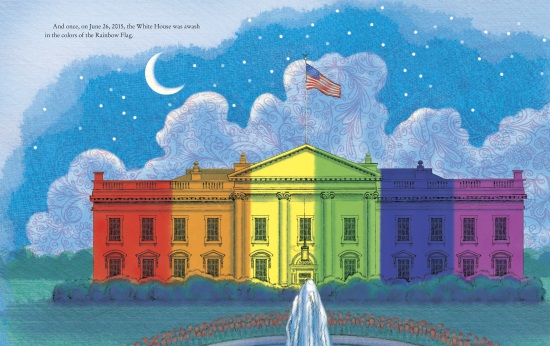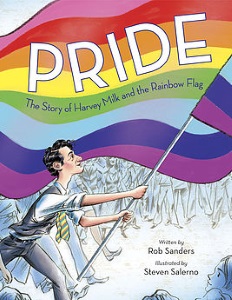Rob Sanders Talks with Roger
Talks with Roger is a sponsored supplement to our free monthly e-newsletter, Notes from the Horn Book.
 Talks with Roger is a sponsored supplement to our free monthly e-newsletter, Notes from the Horn Book. To receive Notes, sign up here.
Talks with Roger is a sponsored supplement to our free monthly e-newsletter, Notes from the Horn Book. To receive Notes, sign up here.Sponsored by![]()
 Photo: Candy Barnhisel.
Photo: Candy Barnhisel.In Pride: The Story of Harvey Milk and the Rainbow Flag, Rob Sanders and illustrator Steven Salerno give us a picture-book history of how the LGBT Pride flag came to be. I talked on the phone with Rob, schoolteacher by day, at his Florida home.
Roger Sutton: What gave you the idea that the rainbow flag could be a subject for a picture book?
Rob Sanders: The real inspiration came on the night of the SCOTUS decision for marriage equality. I watched the news coverage that afternoon, and by the evening it seemed like the whole country, including the White House, was awash in the colors of the rainbow flag. I thought, This is something I don't think kids know about — the importance of this symbol. I wanted to celebrate what was going on in our world by sharing that information with kids in a picture book.
 Art ©2018 by Steven Salerno.
Art ©2018 by Steven Salerno.Roger: As a teacher, how up would you say kids generally are on the topics of gay people, gay rights, gay marriage, etc.?
Rob: It may all depend on what part of the country you live in. I'm in Florida, and I would say that my students today are more aware than kids were fifteen years ago when I moved here. They do see some positive images of gay people represented on TV. They do hear some news reports. Gay parents at our school are more likely to be out than they were before.
Roger: Are you out to your students?
Rob: I don't talk about my sexuality with my students; I don't think any elementary school teacher does. But I am who I am. In retrospect, when they think back about their time with me, it will probably be rather obvious to them that Mr. Sanders was a gay man. That might explain the show tunes during class, and some of the people we study. Langston Hughes, Sally Ride, Richard Blanco — these are important gay and lesbian figures in our country.
Roger: Why did you decide to write your story as a picture book? Those are usually about people or animals.
Rob: Nonfiction is a big part of reading at school, and I know that nonfiction interests kids. I wanted to tell this story not so much from a biography standpoint — there are several children's biographies about Harvey Milk — but none about the flag itself. It was a unique opportunity for me to talk about symbols. Kids at this age are beginning to understand the importance of symbols — the recycling symbol; the flag of the United States. At our school we have a mascot, and that mascot is a symbol for who we are.
Roger: Do kids ever get the assignment to make their own flags?
Rob: You're right in tune with my lesson plan, because that's exactly how I was planning to celebrate the launch of this book with my students. We'll talk about symbols, and then they'll make a flag (or some other project) to express what they're proud of and what would represent them.
Roger: Now I have my new Barbara Walters question — if you were a flag, what flag would you be?
Rob: Something colorful and shiny. I like the one that I share with my community. I would just keep that one.
 Roger: I wanted to let you know how much I learned about the flag from reading the book. I kind of knew Harvey Milk was involved, but I didn't know, for example, that the number of colors changed.
Roger: I wanted to let you know how much I learned about the flag from reading the book. I kind of knew Harvey Milk was involved, but I didn't know, for example, that the number of colors changed.Rob: Yes.
Roger: Because of a printing or a dye problem, was it?
Rob: Yeah. Gilbert Baker originally designed the flag with eight colors, and they each had a meaning. The story goes that as he was getting ready to reproduce the flag, working with the Paramount Flag Company, it turned out the hot-pink dye was difficult to get in quantities, so that color was cut. And then over time the seven stripes just didn't seem to be the appropriate number, and turquoise was eliminated. Because Gilbert assigned significance to each color, that decision was so important initially; but I think we've pretty much forgotten about it, because the flag is a unified symbol now. Kind of like our community. We're very separate until we need to work together for some purpose and we find our ability to be unified.
Roger: I was having a discussion on Twitter — probably not a good idea — about various aspects of the LGBTQ acronym. Who should be on it, what does it stand for — I'm sure you've had these discussions as well.
Rob: Yeah.
Roger: I remember back in college the only discussion was: should it be gay and lesbian or lesbian and gay.
Rob: Who was going to take top billing on the list?
Roger: Right.
Rob: But yeah, it's changed. When I think back, 1978 was after my freshman year in college. I was probably closeted in the Midwest, with friends who were the brave ones to venture out to New York City and LA and other places. At that time, as individuals, we were just all trying to find our way out. Then lesbians and gays started seeing some political power in work they could do together. Over time, it's been really interesting how the letters have expanded — it's like the flag is big enough for all of us. It's not just limited to you and her and he and she. It's for everyone in our community. Just like the rainbow that Gilbert chose because it was in the sky — it was for everyone — the flag is for everyone as well.
Roger: When I was in Provincetown some years ago, there was a store that was chock-full of rainbow paraphernalia, window decals and little flags and handkerchiefs, teddy bears and all that stuff. A woman and her husband were walking by, and she says to him, "It's like they knew I had a rainbow collection!"
Rob: Bless her.
Roger: I don't know who should get the credit, but somebody should be proud that this flag has really taken hold, both as something the gay, lesbian, etc., community has more or less rallied behind, and also that it is recognized by other people out in the world. I'm thinking of that lovely photograph of Tilda Swinton waving the flag in Moscow. That's one of my favorite images of rebellion.

Rob: Gilbert talked about how the rainbow fit us — because it was from nature, because of the connection, because of the variety of colors — it fit all races, all genders, all ages, all of those things. It even includes, maybe, that woman in P-Town who didn't realize what the rainbow was signifying. She could be included as an ally for the community. One of my best straight friends is so proud of the A in the string of letters that we have now [LGBTQIA+], because she feels like she fits as part of the community too.
Roger: A for allies, for those of you who aren't in the know. Do you think Gilbert was aware of the Judy Garland association that so many of us put to the flag, because of "Somewhere Over the Rainbow"?
Rob: I didn't find any evidence of that, or credit to Judy Garland. Poor Judy gets blamed for lots of things in our community — or credited, whichever the case might be — but it's certainly clear for those who have "Somewhere Over the Rainbow" in their hearts.
Roger: Even if it wasn't in Gilbert's mind, that connection might be another reason why the flag itself took hold. Do you remember the lambda symbol? That was around for a while but never really took off.
Rob: Right. And everyone knows the pink triangle. Having something to replace the negative symbol with a positive symbol was so important too.
Roger: Yeah, I always felt ambivalent about the pink triangle.
Rob: Why's that?
Roger: I'm not sure it's something I would want to reclaim.
Rob: Leave it in history.
Roger: Make sure everybody knows the history, but—I wonder how Jews would feel about wearing a yellow star? I guess that's how I feel about wearing a pink triangle.
Rob: Right, I see that.
Roger: Do you have rainbows in your classroom?
Rob: I have a couple of rainbows in my classroom. Not a flag, but a couple of rainbows.
Roger: Do you see them often in the sky in Florida? You get a lot of weather there.
Rob: Oh, we see rainbows all the time in Florida. Tampa is the lightning capital of the world, or so we claim, so we have a lot of opportunities for the storms to be followed by a rainbow. We have big blue skies here in Florida, and huge arching rainbows.
Roger: Do you make a wish when you see one?
Rob: Sure, I've wished on a rainbow. Who hasn't? At times — because I have some childishness still inside me — I still think if I just keep driving, I'm going to get to the end of that rainbow. Hasn't happened yet.
Roger: But who knows?
Sponsored by![]()
RECOMMENDED
ALREADY A SUBSCRIBER? LOG IN
We are currently offering this content for free. Sign up now to activate your personal profile, where you can save articles for future viewing.







Add Comment :-
Be the first reader to comment.
Comment Policy:
Comment should not be empty !!!